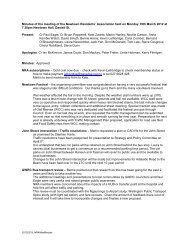Draft Town Belt Management Plan - Wellington City Council
Draft Town Belt Management Plan - Wellington City Council
Draft Town Belt Management Plan - Wellington City Council
Create successful ePaper yourself
Turn your PDF publications into a flip-book with our unique Google optimized e-Paper software.
30<br />
Te Ahumairangi Hill is the highest part of the <strong>Town</strong> <strong>Belt</strong> comprising steep vegetated slopes with<br />
an open ridgeline. The tree cover, which predominates, gives the area a distinctive character<br />
when seen from a distance.<br />
This area is comparatively less developed, more informal and more natural or ‘wild’ with very<br />
few buildings and little formal sport development.<br />
The hill is relatively close to the sea with only a narrow strip of urban landscape between,<br />
contributing to the dominance of the landform over the urban landscape. There are no houses<br />
on the lower slopes and the hill is seen from the city as a steep mass rising from the flats. The<br />
hill is a highly visible and recognisable feature of the <strong>Wellington</strong> city landscape particularly from<br />
the harbour and other vantage points.<br />
3. The eastern side of the horseshoe is formed by Mt Victoria/Matairangi.<br />
This prominent high point comprises an open ridgeline with areas of steep vegetated slope. The<br />
ridgeline character is less uniform in shape with mixed vegetation cover and a greater variety of<br />
use and activity, creating a more complex landscape pattern than Te Ahumairangi Hill.<br />
This area also has a different character to the western end due to urban development extending<br />
part way up the slopes and the edges of the open space not being as clearly defined. The area is<br />
visibly prominent from more places around the city and appears to have a more direct<br />
relationship or connection to the sea.<br />
At the local scale the landscape confers identity and provides coherence, contributing to the<br />
amenities of individual communities and providing the setting for day-to-day experiences. Parts of<br />
the <strong>Town</strong> <strong>Belt</strong> can provide space for a playground, a kick-about space, a picnic spot, a shortcut<br />
route to work, a backdrop to a suburb or view from someone’s window.<br />
At the finest scale the <strong>Town</strong> <strong>Belt</strong> provides individual elements or spaces that are important to a<br />
variety of different people. For example, a particular tree may have heritage value due to its age or<br />
location, cultural value associated with use, ecological value as habitat, aesthetic value, practical<br />
value as shade, or even value associated with a memory of an event in someone’s life.<br />
The <strong>Town</strong> <strong>Belt</strong> provides a significant open space framework for the city and the differences in its<br />
three broad areas – the inner curve, the north-western end and the eastern side – are a large part<br />
of its overall value. The visual diversity and diversity of open space values and experience (across<br />
all scales of space from Te Ahumairangi Hill down to an individual tree) is important in its<br />
protection.<br />
4.2 Landscape objectives<br />
4.2.1 To protect the <strong>Town</strong> <strong>Belt</strong> as a predominantly natural 8 environment in contrast<br />
to the built environment of the city.<br />
4.2.2 To recognise and protect the unique landscape character of the <strong>Town</strong> <strong>Belt</strong> and,<br />
in particular, the:<br />
• ridgeline and hilltop landscapes<br />
• diversity of landscape aesthetic and experience<br />
• patchwork of native and exotic vegetation<br />
8 ‘Natural’ is not intended to mean ‘pristine’ or a landscape unmodified by humans, as the <strong>Town</strong> <strong>Belt</strong> landscape has a long<br />
history of human modification. While there are obviously degrees of naturalness, here the term is used to describe the<br />
difference between the <strong>Town</strong> <strong>Belt</strong> being ‘natural’ and the built environment of the city being not ‘natural’.<br />
<strong>Draft</strong> <strong>Town</strong> <strong>Belt</strong> <strong>Management</strong> <strong>Plan</strong> October 2012





